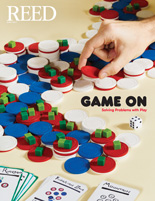
IRIS login | Reed College home Volume 96, No. 2: June 2017
RAW Edges Closer to the Borderline
If you happened to be walking through through New York City’s Chinatown one night last August, you might have noticed the words “Gentrification is modern colonialism” projected onto the wall of M.S. 131. You might have stopped and watched as they were replaced first with animations, then song lyrics, then, a question: “Who did you displace to open your gallery?”
Earlier that evening, the Chinatown Art Brigade—an arts collective dedicated to defending tenants from displacement—had parked a van rigged with equipment next to the school. That night, they projected messages about gentrification and community resilience onto the wall as part of their “Here to Stay” project.
Artist Betty Yu, one of the Brigade’s founders, visited Reed on March 4 to talk about “Resisting Gentrification through Art, Culture, and Activism” as part of Reed Arts Week. This year’s RAW curators, Charlie Perez ‘17 and Daphne Lyda ‘17, organized the five-day festival around the idea of borders.
“A border never just is,” they wrote in their curator’s statement. “Borders are a battleground where reclaiming and legitimizing subordinate identities are read as acts of defiance.”
Student artists displayed drawings in the library, held readings in the Chapel, and transformed rooms in the Gray Campus Center into interactive installations. Visiting artists Pochas Radicales, a queer Latinx art collective, performed in the Cooley Gallery. Minimal Violence, Molly Soda, and Santiago Salazar held a DJ showcase in the Student Union. Artist Rodrigo Valenzuela gave an artist talk. And Betty Yu, whose videos had been playing in the GCC that week, presented a compelling talk about art and activism.
The Brigade uses arts and culture to combat gentrification. Nearly 30% of Chinatown’s low-income tenants have been pushed out of the neighborhood since 2003. Housing costs have soared. Boutiques and bars have popped up everywhere. 120 galleries have moved into the neighborhood, mostly within the last five years. Yu showed a slide of a bakery next to a gallery. The bakery owners, who had been in the neighborhood for years, struggled to pay rent, while the gallerists paid $1500 a month for their storefront. “How many buns do you have to sell to make rent?” Yu asked.
Yu’s work often deals with the boundaries between nations and even neighborhoods. But it straddles other borders, too. For the “Here to Stay” project, CAB collaborated with Chinatown tenants. Initially, she said, “a lot of them felt like, ‘We’re not artists, we can’t do this.’” By the end of the project, however, they had gained the skills and confidence to think up and design the messages and animations projected on M.S. 131. In fact, Yu says, one of the most significant borders that she wants to erase is the one between artists and non-artists.




LATEST COMMENTS
steve-jobs-1976 I knew Steve Jobs when he was on the second floor of Quincy. (Fall...
Utnapishtim - 2 weeks ago
Prof. Mason Drukman [political science 1964–70] This is gold, pure gold. God bless, Prof. Drukman.
puredog - 1 month ago
virginia-davis-1965 Such a good friend & compatriot in the day of Satyricon...
czarchasm - 4 months ago
John Peara Baba 1990 John died of a broken heart from losing his mom and then his...
kodachrome - 7 months ago
Carol Sawyer 1962 Who wrote this obit? I'm writing something about Carol Sawyer...
MsLaurie Pepper - 8 months ago
William W. Wissman MAT 1969 ...and THREE sisters. Sabra, the oldest, Mary, the middle, and...
riclf - 10 months ago